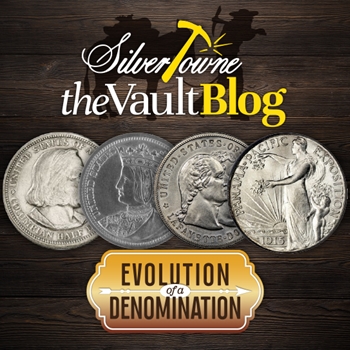
Silver commemoratives have a long history dating back to the late 1800s in the United States and even earlier when it comes to the days of ancient Greeks and Romans. Congress used commemoratives to raise funds for projects related to the historical event depicted on the coins, including building memorials to honor said event. This is what makes commemoratives so unique as they hold historical significance and present the progress in the United States.
World’s Columbian Exposition Half Dollar (1892-1893)
The first commemorative coin issued from the United States was in conjunction with the World’s Columbian Exposition in Chicago. Celebrating the 400th Anniversary of Columbus’ discovery of America, it was sold at the World’s Fair for $1. The half dollar design was created by Olin Levi Warner and the obverse was engraved by Charles E. Barber with the reverse engraved by George T. Morgan. Close to one million 1892 Columbian half dollar commemoratives were sold with the next year’s date of 1893 issuing over 1.5 million coins.
World’s Columbian Exposition Isabella Quarter (1893)
As the second commemorative issued by the United States, the 1893 Isabella Quarter was also created for the World’s Columbian Exposition in Chicago. Mrs. Potter Palmer, a prominent Chicago socialite, insisted on its production as she was also on the Board of Lady Managers for the Exposition. The board was created to make sure female voices were involved in the planning of the fair.
The design, created by Charles E. Barber, features a young Queen Isabella I of Spain on the obverse and a woman kneeling while holding a distaff and spindle on the reverse, symbolizing women’s industry. It was the first issued coin from the United States that featured a foreign monarch. Despite its appeal, the Columbian half dollar in addition with the price point did not help sales of the quarter dollar commemorative. There were just 24,214 distributed by the U.S. Mint despite its maximum mintage of 40,000. However, its low mintage and scarcity today make for its highly collectible nature.
Lafayette Dollar (1900)
The first commemorative of the $1 denomination, the 1900 Lafayette Dollar features the heads of George Washington and 18th century French nobleman, Marquis de Lafayette. It was also the first authorized United States coin that featured the portrait of a United States president. The reverse features the statue like the monument of General Lafayette that was constructed in Paris as a gift from the American people. Designed and engraved by Chief Engraver Charles E. Barber, the coins were sold by the Lafayette Memorial Commission for $2 each. Despite all 50,000 coins authorized bearing the 1900 date, they were struck in 1899. However, as the coins were slow sellers, they were available for years after the Exposition itself for less than the original issue price. Around 14,000 coins were returned to the Mint where they were melted in 1945. The net mintage ended up being 36,026.
Marquis de Lafayette helped the American colonies fight the British in the Revolutionary War. He would leave his life of privilege and help create the country in training. He reached the rank of Major General in the Continental Army and helped reach peace between France and the colonies in 1778. His close relationship with Commander in Chief George Washington also is what would spark the invitation from the United States to participate in the Paris Exposition in 1900. A fitting contribution was the idea of a statue of the war hero, prompting planners to raise funds through the commemorative dollars.
Panama-Pacific International Exposition (1915)
As the Panama Canal would be completed in August of 1914, Congress authorized the Panama-Pacific International Exposition of 1915 in honor of constructing one of the greatest engineering feats in the modern age. The Expo was held in San Francisco and was simultaneously used to celebrate the city’s rehabilitation after the devastation is felt from the 1906 earthquake. Other than the exposition itself, Congress would also pass the authorization of a commemorative coin series honoring the event, including the half dollar.
The half dollar’s obverse featured the figure of Columbia scattering flowers from a cornucopia held by a cherub. Designed by Chief Engraver Charles E. Barber, the design featured the date of 1915 with the San Francico mintmark to the left of the date. George T. Morgan, Barber’s assistant at the time, would come up with the reverse. It features an eagle atop the Union shield with an oak branch representing stability on the left and an olive branch on the right symbolizing peace.
They were sold at the exposition for $1 with tens of thousands of half dollars pre-sold. The authorized mintage was 200,000 with the San Francisco Mint only striking a little over 60,000 during the event. Of the 60,000 initially authorized, 32,866 were left unsold and were eventually melted down. The 1915-S Panama-Pacific International Exposition half dollar has a recorded mintage of just 27,134, contributing to its rarity and demand from collectors.
Source: NGC Coin; The Official 2025 Red Book







